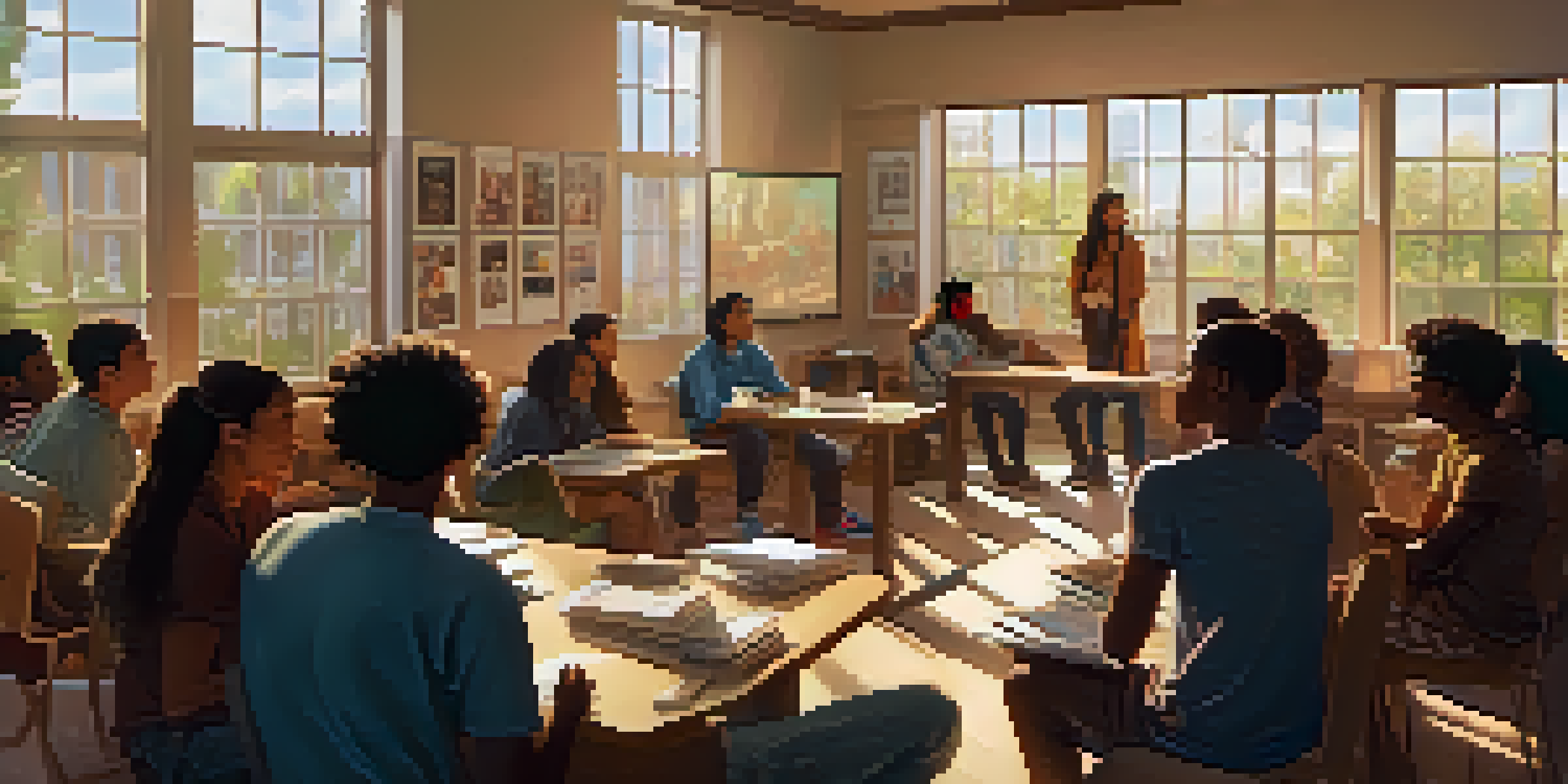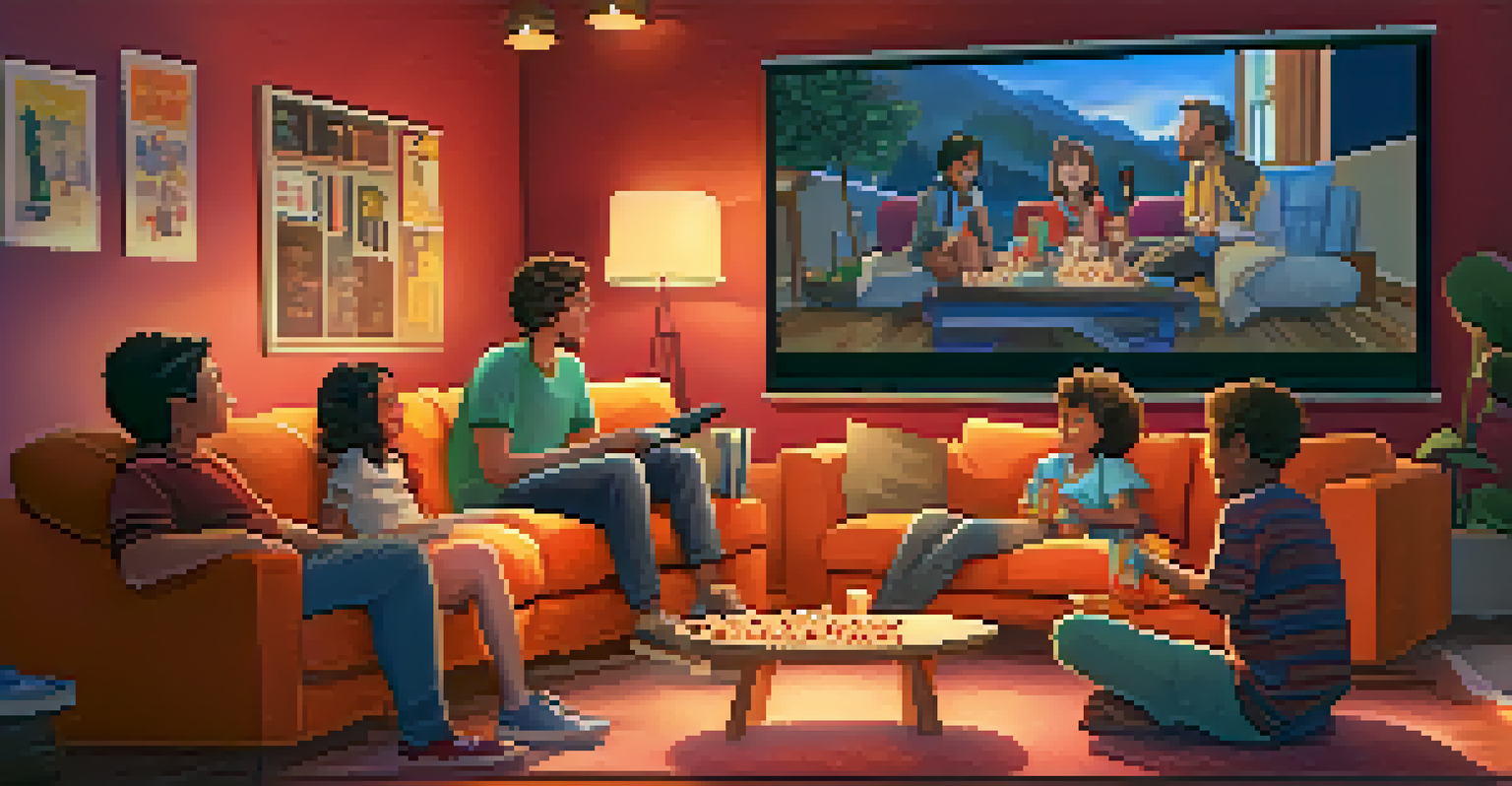Films as a Gateway to Cultural Understanding in Education

The Role of Film in Cultural Education
Films serve as a powerful medium that transcends language barriers, allowing students to experience different cultures firsthand. By portraying diverse narratives, they provide insights into societal norms, traditions, and values that might be unfamiliar to students. This immersive experience can ignite curiosity and foster empathy, making learning about other cultures not just informative, but also engaging.
Film is a powerful medium for cultural education, providing insights into societal norms and traditions that might be unfamiliar to students.
Moreover, films can spark discussions among students, encouraging them to share their thoughts and feelings about the content. This dialogue can lead to a deeper understanding of cultural nuances and promote respect for diversity. When students see characters who reflect their own experiences or those of others, it creates a sense of connection that enhances their educational journey.
Incorporating films into the curriculum encourages critical thinking as students analyze themes, characters, and plots. This analytical approach helps them understand the perspectives presented in the film, fostering a more comprehensive view of global issues. Ultimately, films act as a catalyst for cultural exploration, turning education into a more vibrant and dynamic experience.
Bridging Gaps Through Storytelling
Storytelling is at the heart of every film, and it offers a unique way to convey cultural narratives. Through well-crafted plots and characters, films can illustrate the complexities of life in different cultures, making abstract concepts more relatable. For example, a film about a family navigating challenges in a foreign country can help students grasp the emotional and social realities faced by immigrants.

These stories engage students on an emotional level, allowing them to see the world through someone else's eyes. This empathetic approach fosters a connection that textbooks often struggle to achieve. By experiencing these narratives, students can better appreciate the richness of cultural diversity and the shared human experience.
Films Enhance Cultural Understanding
Films provide immersive experiences that allow students to connect with diverse cultures and foster empathy.
Furthermore, films often highlight social issues prevalent in various cultures, prompting discussions about equality, justice, and human rights. This can empower students to think critically about their own society and consider how they can contribute to positive change. Ultimately, storytelling through film becomes a tool for understanding and unity, breaking down cultural barriers.
Diverse Genres and Their Impact
Different genres of film can offer various insights into cultural understanding. For instance, documentaries provide factual representations of cultural practices, while dramas may illustrate personal stories that highlight emotional truths. Each genre serves a unique purpose in educating students about the complexities of various cultures.
Through storytelling, films can illustrate the complexities of life in different cultures, making abstract concepts more relatable.
Animation, too, can be a powerful tool for cultural exploration. Films like 'Mulan' or 'Coco' not only entertain but also introduce viewers to cultural myths and values in an accessible way. By presenting these stories in a visually captivating format, students are more likely to engage with the underlying messages about cultural identity and heritage.
Moreover, international films allow students to experience languages, dialects, and storytelling styles that differ from their own. This exposure not only enhances their understanding of language nuances but also broadens their perspective on global narratives. By engaging with a variety of genres, students can cultivate a more nuanced appreciation of the world around them.
Cinematic Techniques and Cultural Context
Understanding the techniques used in filmmaking can deepen students' appreciation for cultural narratives. Elements such as cinematography, sound design, and editing can significantly influence how a story is perceived. For example, the use of specific colors or music can evoke emotions that are culturally significant, enhancing the viewer's connection to the film.
Studying these techniques encourages students to analyze how filmmakers convey cultural values and messages. This analytical approach not only enriches their viewing experience but also develops their critical thinking skills. By examining how different cultures are represented through film, students become more aware of the subtleties that shape cultural identity.
Storytelling Builds Emotional Connections
Through relatable narratives, films engage students emotionally, helping them understand complex cultural realities.
Additionally, discussions about these cinematic choices can lead to broader conversations about representation and bias in media. By exploring who gets to tell a story and how, students can critically engage with the content and consider its impact on cultural understanding. This awareness empowers them to become discerning viewers and informed citizens.
Films as a Reflection of Society
Films often mirror the societal values and struggles of the time in which they were created. By analyzing historical films, students can gain insights into the cultural and political contexts that shape societies. For example, films set during significant historical events can help students understand the impact of those events on different cultures.
This reflection can be particularly powerful for discussing contemporary issues such as racism, gender equality, and globalization. By viewing films that address these challenges, students can learn about the diverse perspectives that exist within their own society and beyond. This understanding can inspire them to engage in meaningful conversations about social justice.
In this way, films become a lens through which students can examine their own cultural identities and the world around them. They can identify similarities and differences, fostering a greater sense of community and shared responsibility. Ultimately, films not only entertain but also educate, serving as a mirror to society that sparks critical reflection.
Creating a Safe Space for Discussion
Engaging with films in an educational setting creates opportunities for open dialogue about cultural issues. Teachers can facilitate discussions that encourage students to express their thoughts and feelings about the film's content. This dialogue is crucial for developing a safe and inclusive classroom environment where diverse perspectives are welcomed and valued.
When students feel safe to share their views, it promotes active listening and empathy among peers. This kind of environment fosters mutual respect and understanding, essential components of cultural education. By addressing sensitive topics presented in films, students learn how to navigate difficult conversations with grace and awareness.
Classroom Films Encourage Open Dialogue
Incorporating films into education promotes discussions that challenge stereotypes and enhance cultural competence.
Furthermore, these discussions can help dismantle stereotypes and misconceptions about different cultures. By sharing personal experiences and reflections, students can challenge preconceived notions and broaden their understanding. In this safe space, films become a powerful tool for building community and fostering cultural competence.
Practical Applications in the Classroom
Incorporating films into the curriculum can take many forms, from themed movie nights to film analysis projects. Teachers can curate a selection of films that align with their lesson plans, providing students with a rich source of cultural content. For instance, pairing a film with a corresponding literature unit can deepen students' understanding of themes and cultural contexts.
Additionally, projects that involve creating short films allow students to express their own cultural experiences and insights. This hands-on approach encourages creativity while reinforcing the lessons learned from viewing diverse films. By engaging students in both viewing and creating, educators can enhance their cultural understanding in a dynamic way.

Moreover, assessments can include reflective essays or group discussions that encourage students to articulate their thoughts on the films viewed. These activities not only assess comprehension but also promote critical thinking and personal reflection. Ultimately, practical applications of film in the classroom create an enriching educational experience that celebrates cultural diversity.